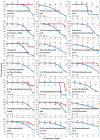High-Throughput Screening of ToxCast PFAS Chemical Library for Potential Inhibitors of the Human Sodium Iodide Symporter
- PMID: 36821091
- PMCID: PMC12050117
- DOI: 10.1021/acs.chemrestox.2c00339
High-Throughput Screening of ToxCast PFAS Chemical Library for Potential Inhibitors of the Human Sodium Iodide Symporter
Abstract
Over the past decade, there has been increased concern for environmental chemicals that can target various sites within the hypothalamic-pituitary-thyroid axis to potentially disrupt thyroid synthesis, transport, metabolism, and/or function. One well-known thyroid target in both humans and wildlife is the sodium iodide symporter (NIS) that regulates iodide uptake into the thyroid gland, the first step of thyroid hormone synthesis. Our laboratory previously developed and validated a radioactive iodide uptake (RAIU) high-throughput assay in a stably transduced human NIS cell line (hNIS-HEK293T-EPA) to identify chemicals with potential for NIS inhibition. So far, we have tested over 2000 chemicals (US EPA's ToxCast chemical libraries PI_v2, PII, and e1K) and discovered a subset of chemicals that significantly inhibit iodide uptake in the hNIS assay. Here, we utilized this screening assay to test a set of 149 unique per- and polyfluoroalkyl substances (PFAS) (ToxCast PFAS library) for potential NIS inhibition. For this evaluation, the 149 blinded samples were screened in a tiered approach, first in an initial single-concentration (≤100 μM) RAIU assay and subsequent evaluation of the chemicals that produced ≥20% inhibition using multiconcentration (MC) response (0.001-100 μM) testing in parallel RAIU and cell viability assays. Of this set, 38 of the PFAS chemicals inhibited iodide uptake ≥20% in the MC testing with 25 displaying inhibition ≥50%. To prioritize the most potent PFAS NIS inhibitors in this set, chemicals were ranked based on outcomes of both iodide uptake and cytotoxicity and normalized to perchlorate, a known positive control. Consistent with previous findings, PFOS and PFHxS were again found to be potent NIS inhibitors, yet significant inhibition was also observed for several other screened PFAS chemicals. Although further studies are clearly warranted, this initial screening effort identifies NIS as a molecular target for potential thyroid disruption by this persistent and structurally diverse class of chemicals.
Figures

References
-
- Murk AJ, Rijntjes E, Blaauboer BJ, Clewell R, Crofton KM, Dingemans MM, Furlow JD, Kavlock R, Köhrle J, Opitz R, Traas T, Visser TJ, Xia M, & Gutleb AC (2013). Mechanism-based testing strategy using in vitro approaches for identification of thyroid hormone disrupting chemicals. Toxicol in vitro:, 27(4), 1320–1346. doi:10.1016/j.tiv.2013.02.012 - DOI - PubMed
-
- Haddow JE, Palomaki GE, Allan WC, Williams JR, Knight GJ, Gagnon J, O’Heir CE, Mitchell ML, Hermos RJ, Waisbren SE, Faix JD, & Klein RZ (1999). Maternal thyroid deficiency during pregnancy and subsequent neuropsychological development of the child. N Engl J Med. 341(8), 549–555. doi:10.1056/NEJM199908193410801 - DOI - PubMed
Publication types
MeSH terms
Substances
Grants and funding
LinkOut - more resources
Full Text Sources
Research Materials
Miscellaneous

